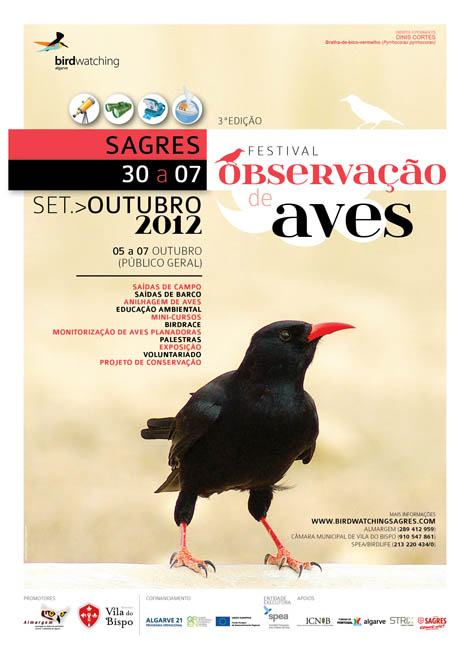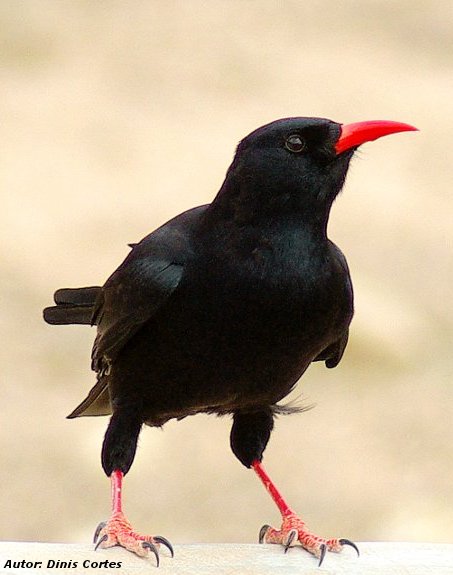 The 3rd Festival of Bird Watching of Sagres will take place from September 30th to October 7th, with the last three days for the general public and the rest for specific audiences.
The 3rd Festival of Bird Watching of Sagres will take place from September 30th to October 7th, with the last three days for the general public and the rest for specific audiences.
Thus, from September 30th to October 4th, the Festival will be open only to specific audiences, such as companies, technicians from City Councils, Universities, schools in the municipality of Vila do Bispo, hunters, fishermen and the local population.
The last three days are reserved for the general public, with activities that include boat trips, field trips, mini-courses, workshops, ringing sessions, monitoring of birds of prey, environmental education activities for parents and children, among many others.
In order to involve students from kindergartens and 1st cycle schools in the municipality of Vila do Bispo, the organization will launch a school competition for them to give free rein to their imagination and creativity and build a bird, using the reuse of materials, with a fence. one meter high.
During the Festival, these birds will liven up the village of Sagres, being found scattered over emblematic places.
The winning group will enjoy a guided tour in the company of eared friends, where they can ride the donkeys or be their guides, on the Costa Vicentina, close to the donkey farm, in Aljezur. This prize is offered by “Donkeys and Arts” and “Walkin'Sagres”.
The Bird Watching Festival in Sagres is organized by Associação Almargem, Portuguese Society for the Study of Birds (SPEA) and Vila do Bispo Municipal Council.
Local agents, including accommodation, restaurants and tourist entertainment, joined those entities to welcome participants, offering special prices and other advantages.
The program is not finished yet, but you can already settle these days in your schedule and keep up to date with the news through the festival website.
Red-billed jay is the “face” of the Festival

The “face” of the poster of the 3rd Festival of Sagres is the red-billed jay (Pyrrhocorax (pyrrhocorax), a species usually associated with high mountains with inaccessible cliffs and ravines. However, it also does well on steep coastal cliffs, nesting for example in marine caves.
Cabo de São Vicente is one of the best places in the country to observe this bird, given the ease with which we come across groups of individuals and the proximity to which they are sighted, contrasting with the distant observations achieved in high mountains.
The southwest coast provides good ecological conditions for this species in danger of extinction in Portugal, being one of its last refuges in Portugal.
Other places where it still resists are Serras de Aire and Candeeiros, Douro Internacional, Alvão and Gerês.
The population of this emblematic corvid has suffered a sharp decrease in our country, following the global trend of the species.
It is estimated that since the late 1980s the Portuguese population has decreased by almost 60%.
The abandonment of extensive agriculture and traditional grazing, the expansion of forest areas and the increase in human pressure, either by opening new accesses or by increasing speleology and climbing in sensitive areas, are the main threats to this species.
Sagres – a must-see destination for birdwatchers
Sagres is a very special region. Not only is the landscape that surrounds it spectacular, but its biological heritage is unique in Europe.
Here you can find a huge diversity of habitats, from marine to forest, passing through estuarine, dune and agricultural, which are naturally home to hundreds of species of fauna and flora.
There are several floristic endemisms, numerous cetaceans, land mammals and, of course, many birds.
The latter are the main attraction of this festival and, therefore, the activities program is mostly centered around them. The event aims to attract participants with different tastes, expectations and knowledge, being ideal for students, nature lovers, more or less experienced birdwatchers, families, etc.
During the days of the festival, numerous initiatives are available, such as field trips, boat trips, bird monitoring actions with experts, thematic lectures, courses, games, gatherings, environmental education activities, among many others.
















Comments